WORLD CLASS COACHING
Build Up From the Back - Exercises 2
By Luca Bertolini
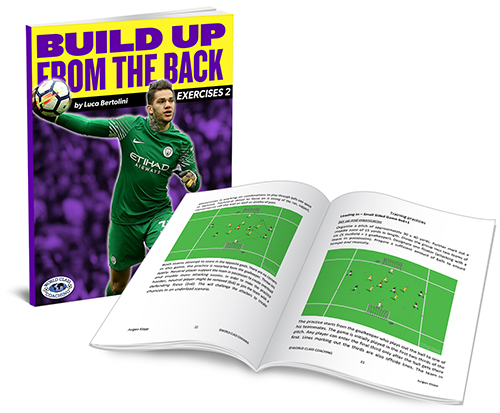
Table of Contents
PART FOUR
Build Up with the 4-3-3 and 4-2-3-1
Build up from the back with the 1-4-2-3-1
The 4-2-3-1 is one of the most popular soccer formations in the game nowadays; it is designed to out-number the opposition in the middle third and it has enough flexibility to support both the defense and the attacking phases quickly and effectively.
The 4-2-3-1 opening shape to play out from the back, when the goalkeeper plays the ball in, is usually the classic positioning of the players, which is required by "La Volpe Exit.”
The field is made as big as possible to play the ball out and to create overloads near the ball. The center backs move toward the corners of the penalty area, the fullbacks push high up the field and wide, 1 of the defensive midfielders drops in between the 2 center backs. The outside midfielders stay closer to the middle to allow space for the wingers and fullbacks. These are the reason why the fixed back three is coming back in vogue during last two seasons.
The most famous development of the 1-4-2-3-1 is the 1-3-3-3-1 of Marcelo Bielsa, covering the whole width of the pitch.
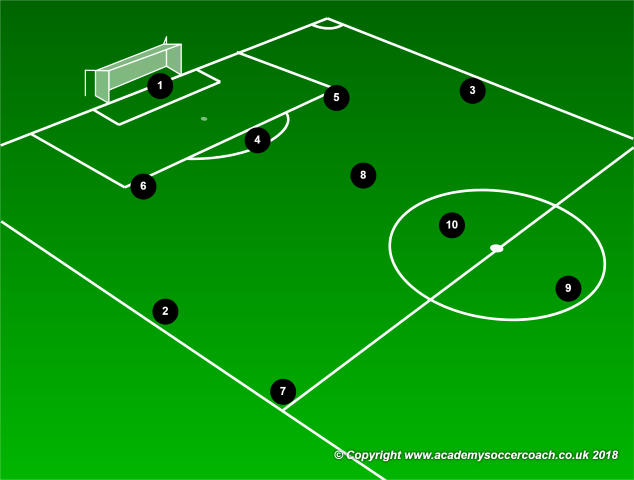
Exercise 23: 6 + 3 + gk v 4 + gk (1)
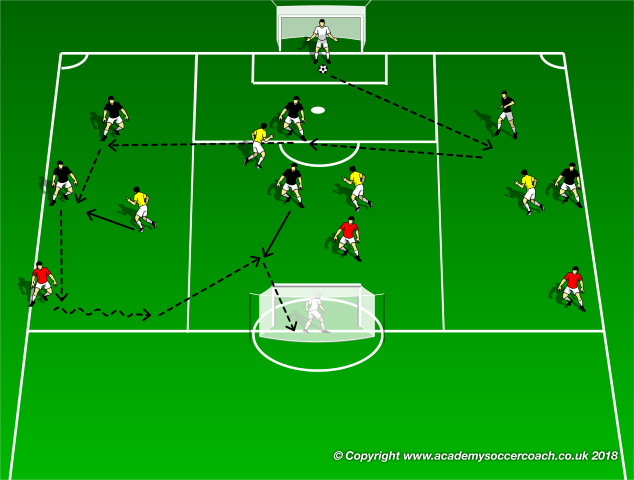
Set-up and Sequence: A half of a regular field is divided into three areas vertically. 2 black players are place inside each area, as well as 1 yellow and 1 red free player. The goalkeeper is in possession.
The black players shape the first two lines of three and the reds shape the third one, before the opposition goal. The building up phase starts with an outside pass (on the left in the picture) and then switching the side through the center space of the first line. The yellow players are free to move all around.
The playing out phase has to be developed along the flank to send the ball to the last line of red free players. The finishing phase has to be carried out through a forward cutting run of midfielder from the second line.
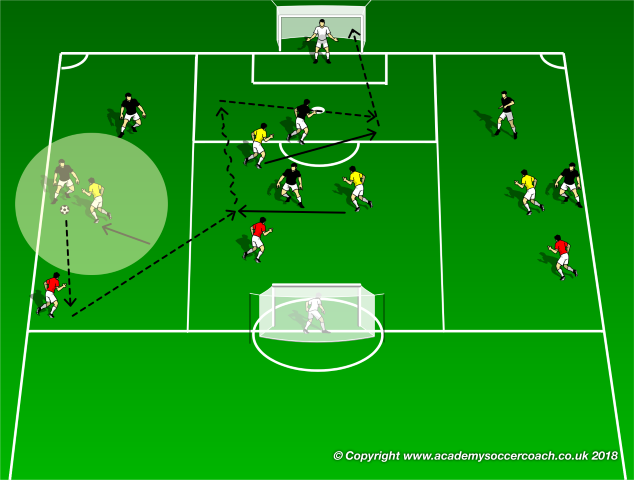
If a defender wins the ball, and wherever the possession is won back, a 4 + 3 v 6 + gk is played to finish in the goal, where the moves started. The players must be active inside the area, where they are placed. The goal worth double if the move is developed and finished in the center area.
Variation: if the defenders win the ball, a 4+3+gk v 6+gk possession game is created; the red free player supports the new team in possession now.
Eye on: pass from the flanks using the middle players as link players to switch the side.
Exercise 24: 6 + 3 + gk v 5 + gk (2)
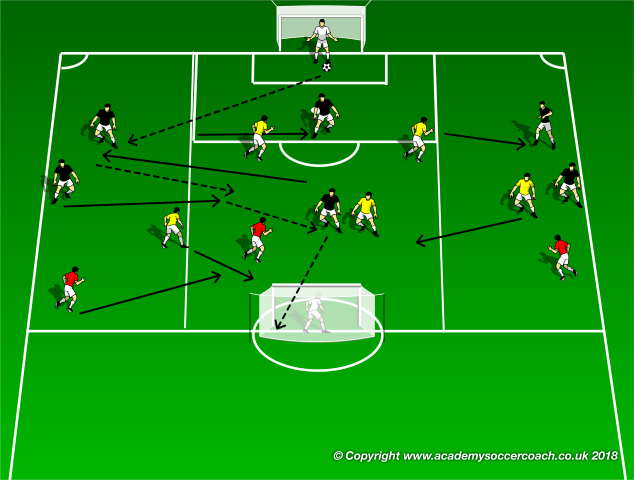
Set-up and Sequence: A half of a regular field is divided into three areas vertically. 2 black players are place inside each area, as well as 1 yellow and 1 red free player. The goalkeeper is in possession.
The black players shape the first two lines of three and the reds shape the third one, before the opposition goal. The building up phase starts with an outside pass (on the right in the picture) and then through the overloaded center space. The yellow players are free to move all around, but they must overload the center to prevent the forwards from shooting and to win the possession back.
The play out phase has to be developed through the center to send the ball to the last line of red free players. The finishing phase has to be carried out through a forward cutting run of a midfielder from the second line.
Variation: if the defenders win the ball, a 6+1 v 6+gk possession game is created. The red free player supports the new team in possession now.
Eye on: pass from the flanks using the middle players as link players to switch the side.
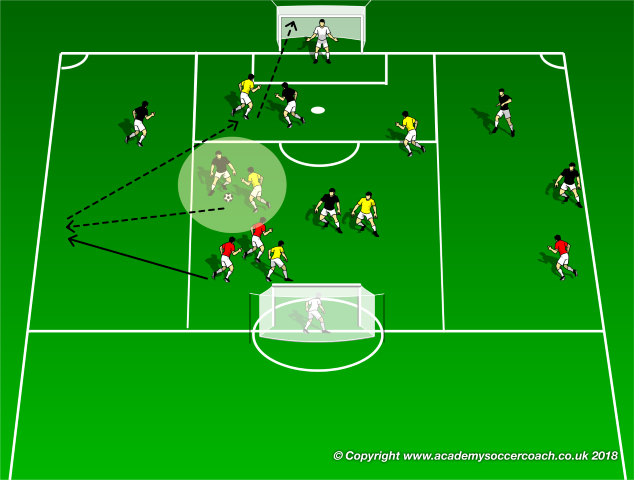
If the defenders win the possession, they must counter attack playing outside first and then finishing in the center.
Variation: if the defenders win the ball, a 5+1+gk v 6+gk possession game is created. The red free player supports the new team in possession now.
Eye on: overload the center to play out, exchange inside/outside positions.
Build up from the back with the 1-4-3-3
The basic shape to build up is usually a 1-2-3-2-3 to stretch the opposition by making the pitch as big as possible, which will allow for opening of space as for the 1-4-2-3-1.
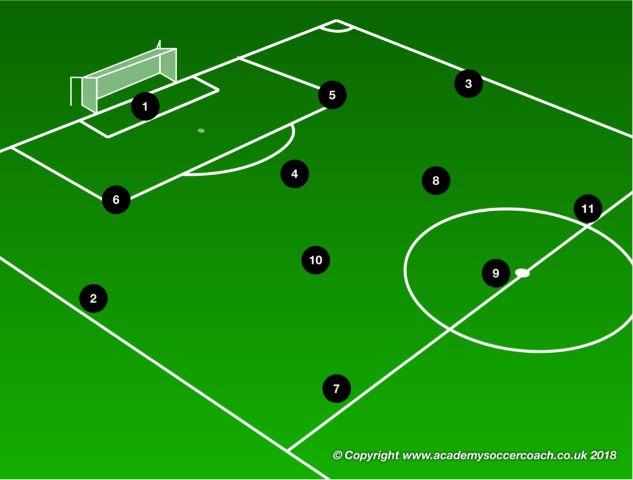
Variation 1 – Dropping down the sides of the box to play to the centre backs
Variation 2 – Dropping down the sides of the box to play to the defensive midfielder
Variation 3 – Playing to the centre back under pressure
Variation 4 – Playing to the defensive midfielder under pressure
Variation 5 – Playing to the defensive midfielder in a situational back three
Exercise 25 (for variation 1):
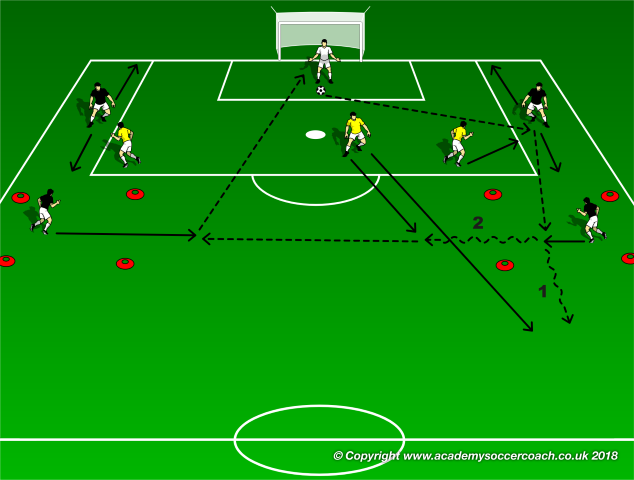
Set-up and Sequence: a quarter of a regular field is used in this exercise. 2 square areas are placed on the flanks just out of the penalty area and 2 fullbacks play inside them. The center backs move along the sides of the penalty area. 3 yellow players are placed along the borders of the penalty area as defenders. The goalkeeper is in possession.
The goalkeeper decides which the center back receives (the left one in the picture); as the center back receives, he plays forward toward the next square area, where the fullback is free to play until a defender comes inside from the penalty area to counter him. The center back is under pressure of a yellow player.
The fullback can decide to dribble forward or toward the center to combine with the opposite fullback, who shifts across the center and he passes back to the goalkeeper to start the sequence again.
If the defenders win the ball, they can counter attack directly.
Eye on: pass quickly before being under pressure
Exercise 26 (for variation 2): 3 v 3 to overcome the first pressure line
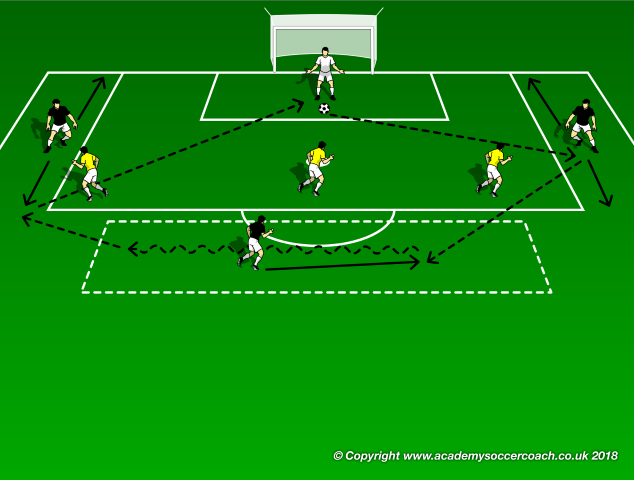
Set-up and Sequence: a rectangular zone is placed out of the penalty area, where a balance midfielder plays. 2 center backs move along the sides of the penalty area and 3 yellow players act as defenders along the borderlines of the penalty area.
The goalkeeper decides which center back receives (the left one in the picture); as the center back receives, he plays forward to the balance player, overcoming the line of pressure of the yellow players. The balance midfielder is free to receive and to play to switch the side, playing toward the opposite center back, who passes back to the goalkeeper to start the sequence again.
If the defenders win the ball, they can counter attack directly.
Eye on: pass quickly before being under pressure and switch the side as soon as possible.
Exercise 27 (for variation 2)-progression: 3 v 3 to overcome the first pressure line and following 1 v 1
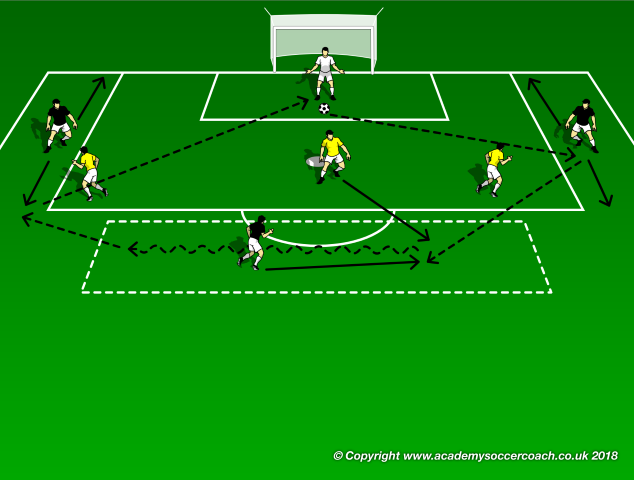
Set-up and Sequence: a rectangular zone is placed out of the penalty area, where a balance midfielder plays. Two center backs move along the sides of the penalty area and three yellow players act as defenders along the borderlines of the penalty area.
The goalkeeper decides which center back receives (the left one in the picture); as the center back receives, he plays forward to the balance player, overcoming the line of pressure of the yellow players. The balance midfielder is under pressure of a yellow player, who runs out the penalty area; the objective is to switch the side, playing toward the opposite center back, who passes back to the goalkeeper to start the sequence again.
If the defenders win the ball, they can counter attack directly.
Eye on: pass quickly before being under pressure and switch the side as soon as possible.
Exercise 28 (for variation 3):
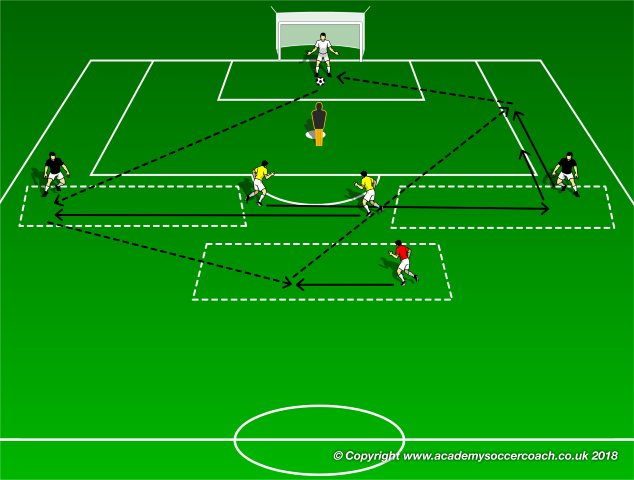
Set-up and Sequence: 3 rectangular areas are placed out of the penalty area, as in the picture. 1 balance midfielder plays inside the center one and 2 center backs move around the wide ones. 2 yellow defenders are placed between the outer area and 1 air-body is placed in the middle of the penalty area. The goalkeeper is in possession.
The goalkeeper decides which center back receives (the right one in the picture); as the center back receives, he plays forward to the balance player, overcoming the line of pressure of the yellow player who is running to counter him.
The center backs must be unmarked on a different line of the center air-body. The balance midfielder plays to switch the side toward the opposite center back, who then passes back to the goalkeeper to start the sequence again.
If the defenders win the ball, they can counter attack directly.
Eye on: pass quickly before being under pressure and switch the side as soon as possible.
Exercise 29 (for variation 4):
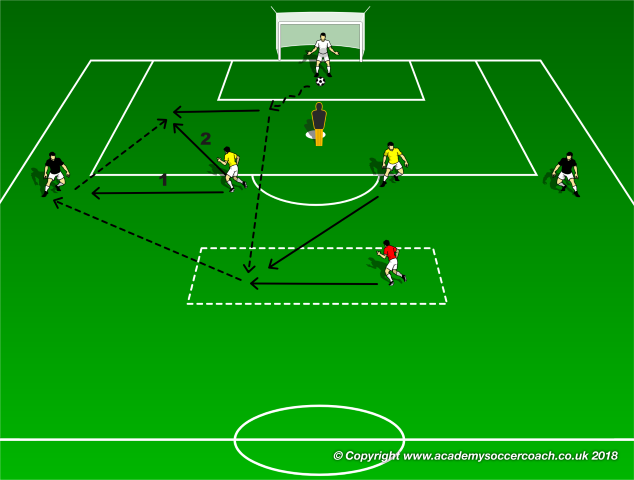
Set-up and Sequence: 1 rectangular area is placed out of the penalty area as in the picture. 1 balance midfielder plays inside it and 2 center backs move around the corners of the penalty area. 2 yellow defenders are placed between the outer area and the borderline of the penalty area. 1 air-body is placed in the middle of the penalty area. The goalkeeper is in possession.
The goalkeeper passes the ball to the center balance player, who must be unmarked at the back of the air-body, as the goalkeeper must be able to see him; as he receives, he passes out toward the nearest center back, who then passes back to start the sequence again.
The first defender runs inside the center area to counter the balance player and the second one put pressure on the center back as he receives.
If the defenders win the ball, they can counter attack directly.
Eye on: pass quickly before being under pressure and switch the side as soon as possible.
Exercise 30 (for variation 5)
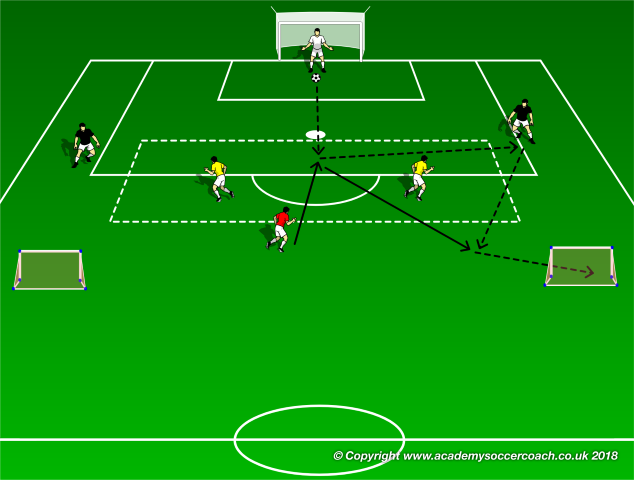
Set-up and Sequence: 1 rectangular area is placed on the border as centerline of the penalty area, as in the picture. 1 balance midfielder is placed just out of it and 2 center backs move around the corners of the penalty area. 2 yellow defenders are placed inside the center area. The goalkeeper is in possession.
The goalkeeper passes the ball to the center balance player, who drops back to receive; as he receives, he passes out toward the nearest center back, who then passes forward on the run of the balance player, who can finish in one of the mini goals.
The defenders are free to press the balance player all over the center area and to close the passing lanes toward the mini goals.
If the defenders win the ball, they can counter attack directly.
Eye on: pass quickly before being under pressure and finish as soon as possible.
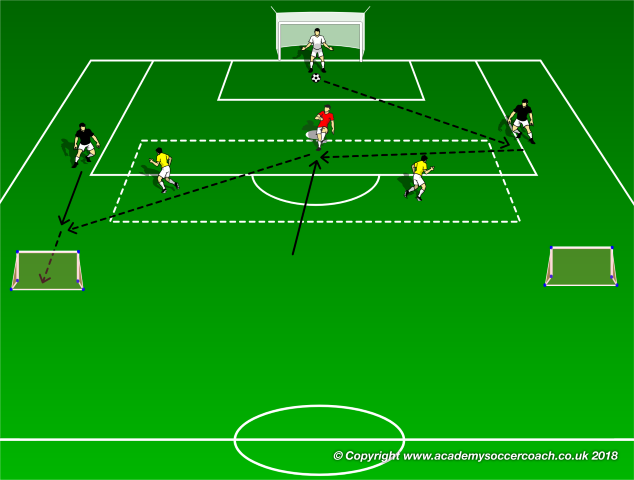
Variation: if the goalkeeper passes the ball to one of the center backs, the balance midfielder drops back to receive and to switch the side, toward the opposite center back, who must score in the mini goals as soon as possible.
The defenders must play as in the previous practice.


